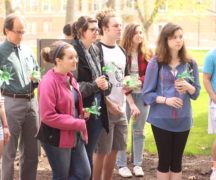By DAVID DUPONT
BG Independent News
Bowling Green State University has been holding onto more students in recent years.
Keeping students once they are recruited is as important as recruiting them in the first place. That boost in retention – making sure students who come in as freshman end up leaving as BGSU graduates – is crucial to the university’s financial health. The state funding formula demands it.
That increased retention is no accident, Provost Rodney Rogers told faculty senate this week. Much of the credit goes to the first-year initiatives designed to integrate new students into the BGSU academic culture from their earliest days on campus.
When Vice Provost for Academic Affairs John Fischer took his turn at the podium to spell out those programs, he said he wished he had the scroll used at this year’s Oscar ceremonies where the names of agents, publicists, hairdressers, and moms that the stars wanted to thank ran at the bottom of the screen. The programs designed to keep freshmen around for the spring semester and beyond are built on a foundation of collaboration with the faculty.
Some colleges and universities are opting to take a more economic look at education, for example, by having students take more online courses, Fischer said.
BGSU, however, “has put its flag in the sand that we’re going to put the quality of the experience ahead” of those other considerations. “That’s what we are going to measure and count and pay attention to and argue about.”
That seems to be working. Students, for example, who take linked courses are more likely to continue at BGSU.
Linked courses are one of several approaches the university takes.
The program enrolls groups of students in the same course sections. That way they see familiar faces in a couple of their classes. Having students take the same two course sections also has the collateral effect of students sometimes ending up together in other classes since it narrows the other scheduling possibilities.
Fischer said faculty see this working when students arrive at class buzzing with talk about another course.
Giving students more opportunities to talk to fellow students and a chance to communicate with faculty are key goals of the first-year programs.
When the linked courses are offered for the third year next fall, he said, the goal is to have more communication between those teaching the courses, so they can better connect the course material. He said this will not be required, but the administration is looking into what kind of incentives can be put into place to encourage it.
Another way to engage students is for them to take the first course in their major in their first semester. In Creative Writing, he said, there’s a correlation between students who do this and whether they will continue at BGSU.
Students arrive, he said, anxious to launch their careers. “How do we engage that excitement that they feel and help steer them to both deepen what we expect of them and raise their expectations of what we expect from them.”
First year seminars are specifically designed to inculcate them to college academic life. Seminars are offered on a variety of topics including being an engaged citizen, how a statistician reads the sports papers, to vaccinate or not to vaccinate, and Batman in American Culture.
Students in a seminar on water quality taught by George Bullerjahn headed up to Lake Erie on their first day to gather water samples.
These seminars, Fischer noted, are often taught by senior faculty members who usually teach upper level students in their discipline. They may never have taught first-year students, or at least haven’t in many years. So they need to adjust their expectations.
The seminars are designed not “to impart a body of information” as much as to inculcate in students what it means to be part of the university experience. That includes how to read and follow a college syllabus.
“We want to engage them and get them thinking about what academic work looks like, what our research agenda looks like … and how it’s connected to a particular set of classes in a discipline,” he said.
Engaging students in residential communities, such as the Global Village and the Arts Village, are also ways to help student make the transition.
The question is how to reach the 460 first-year students who are not involved in any of these programs. These students, Fischer said, are usually athletes or students who come in with “30 credits in their back pocket” or some other academic achievement.
Fischer said with College Credit Plus, which expands the number of students who can earn college credits while still in high school, may increase the number of those students.
In the discussion that followed. Joel O’Dorisio, of the School of Art, said it would be good if faculty in linked courses were given time to work together. Sometimes they may not even know their courses are linked. Fischer said ways of doing that are being studied. Often courses are linked, he said, before professors have been assigned to them. That limits the amount of time before the semester for collaboration.
Michelle Heckman, of the Math Emporium, said students “have no clue how to study… study skills are critical.” That should be incorporated more into these courses aimed at arriving students.
Geology professor James Evans said it was essential that students understand that learning what it means to be a professional in a discipline is more important than what grades they receive.
First-year programs aim to turn high school students into college scholars
 John Fischer addresses BGSU Faculty Senate in 2016.
John Fischer addresses BGSU Faculty Senate in 2016.



